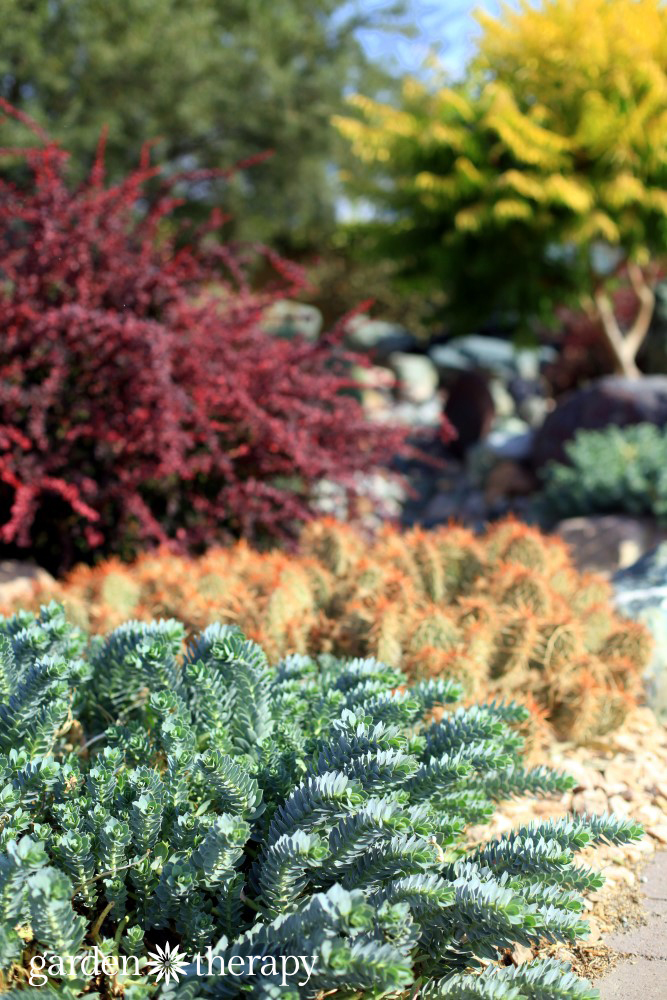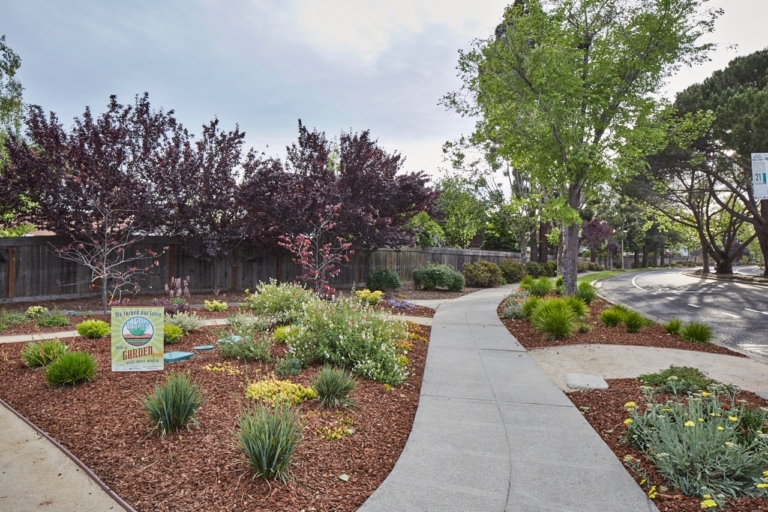Table Of Content

Plants that are native to a particular region are typically the most drought-tolerant. Native plants grow naturally in the region where they originally evolved which means they have adapted to the environment, support the surrounding ecosystem, and require little maintenance or water. For drought-tolerant landscaping to survive and thrive you need to be able to save and collect as much water as possible. Water plants deeply but less frequently, which uses less water and puts water where a plant most needs it, which is at the roots.
Water wisely.
A compact, early-blooming variety with lemon-yellow flowers held above ferny foliage. The perfect size for containers, or at the front of a sunny border or butterfly garden. A profusion of bright, velvety, red blooms on elongated stalks branching out of clumps of bright green, sword-like foliage. A compact gem that will provide months of dynamic, carefree color for waterwise gardens. It’s hard to decide what’s more impressive in this hot hillside garden—the vibrant colors or the bold textures. This space proves that you can combine plants with both eye-catching hues and standout foliage to great effect.
How is Xeriscaping Different?
Water-wise landscapes can be lush and overflowing with plants, but achieving that look requires making informed plant choices. The following drought-tolerant designs offer inspiration if you’re looking to use less water but not sacrifice any beauty. Drought-tolerant landscaping includes plants that do not need much water to thrive.
Add dry ground cover plants
Native plants or plants that will work in your hardiness zone will have deep root systems that allow them to access water stored in lower soil layers. Use low maintenance shrubs, succulents and perennial plants to create a structural layer of landscaping around trees. This low-growing sedum has color-retentive, cherry-red foliage, and is perfect for waterwise landscapes or patios. Eye-catching as a groundcover or accent in a rock garden or container. The spaces between the curb and sidewalk are sometimes known as "hell strips" because they tend to be hot, dry places. But they can also become a lush oasis with the right water-wise design.
Mediterranean backyard design tips from a landscape designer - Homes & Gardens
Mediterranean backyard design tips from a landscape designer.
Posted: Fri, 19 Jan 2024 08:00:00 GMT [source]
DROUGHT TOLERANT GARDEN IDEAS
“You’ll save anywhere from hundreds to honestly thousands of dollars on water a year,” Cody Simpson, the Chief Landscape Consultant at Droughtscape, a Glendale-based landscaping company told the I-Team. Get a custom professional design to DIY, order the materials you need, and build the yard of your dreams one project at a time. Sign up for our email list to receive exclusive promotions and landscape design inspiration.

So instead of struggling to carry on with traditional garden styles, which require lots of irrigation, a sustainable and low maintenance garden option is to dispense with watering altogether. If you live in a low-rainfall area or have sandy, free-draining soil, dry gardens might be the ideal style for your backyard. These low-maintenance plants are known for their soft, gray-green leaves and four-petaled flowers on 8 to 12-inch stems. Not only does this plant increase the visual interest of a flowerbed design, but it also thrives in well-drained soil and tolerates poor soil conditions once established.
Benefits of Drought-Tolerant Landscaping
Clumping rosettes make an excellent waterwise groundcover when planted en masse. Densely packed, blue-green, narrow, succulent leaves grow in a symmetrical fashion from sprawling fleshy stems. Striking texture and color, perfect for massing in a sunny, low-water garden or succulent planting. This rugged, cold hardy, native grass features blue-green foliage and striking, flag-like, golden summer flowers on stiff, weather-resistant stems. Tolerant of many soil types, this is a perfect choice for low-maintenance landscapes.
Opt for clever water management solutions
Whether you live in the desert or a climate that receives more rainfall, there are many ways you can reduce usage or conserve water in your yard. Many plants supply showy blooms but require tons of water; in place of them, hardscape elements like this circular walkway of pavers around a gravel center furnish visual interest. Garden art, like the sculptures of a whimsical cat and an orb, also can offer interest in place of water-needy plants. This water-saving landscape still looks lush, thanks to the careful selection of shrubs and evergreens that require very little supplemental water (except in times of extreme drought). Drought-tolerant groundcovers, such as the thyme shown here weaving between large stones, provide a good way to catch rainwater that may run off the hardscaping, especially on a gentle slope.
Flora Terra’s trained team of drought-tolerant landscape design architects can create a sustainable commercial outdoor space. Our commercial landscape designers use colorful native plants and trees that thrive in your growing conditions and are easier to maintain. Designer Lisa created a lush, meadow-style landscape that provided space for everything the client wanted in their homestead with plenty of room to grow.
Avoid contact with the white milky sap, which can cause skin irritation or severe eye damage. Use groundcovers as a living mulch to slow water evaporation in your drought-tolerant landscape. These low-growing plants also can help minimize water runoff from hardscaping such as steps and sidewalks. Here, water-wise perennials such as thyme, sedum, and sea thrift are small enough to be tucked between and around these stone steps. Our client wanted a low-maintenance, drought-resistant landscape design that would flourish in his hot and dry climate.
Plus, the gravel makes a permeable walkway, helping to prevent water runoff. Texas also has an annual Water-Efficient Products Sales Tax Holiday during Memorial Day weekend. During this holiday, products like drip irrigation hoses, moisture control sprinklers, mulch, compost, soil, and more can be purchased tax-free. Some local governments and organizations also offer rebates for water-efficient landscaping so check your local municipality for water-efficiency and xeriscaping programs and rebates. Tilly’s easy online landscape design process has been embraced by homeowners across the country and in Canada.
In gardens with wet clay soils, try planting in raised garden beds to provide them with sufficient drainage. Dry gardens can be an oasis with shady trees, low-water plants and heat-tolerant flowers for pops of seasonal color. Russian sage is another versatile option that offers both beauty and culinary uses. This classically beautiful plant has gorgeous purple, white, or pink blooms. Sage thrives in dry conditions with minimal supplemental watering.
Due to its spreading habit, it’s often used in wildflower gardens, borders, and as cut flowers. This plant is highly sought after for rock gardens and landscapes with a Mediterranean theme. Rock Rose plants are drought-tolerant shrubs that produce a profusion of papery flowers in white, pink, or yellow shades.
For much of the last 23 years the Southwest has been dealing with a “megadrought,” which not only is expected to persist but is likely to intensify and expand east. As you may have already guessed, this lack of water has had implications for gardeners and landscapes. Plants that require constant and consistent moisture are no longer viable (or responsible) choices for many of our beds and borders. Instead, as temperatures rise and rain events become scarcer, it’s smart—from both an environmental and economic standpoint—to invest in plants that can take it drier. Many folks assume this means transitioning their lush, leafy gardens into desert-like xeriscapes.
And some of them even prefer growing in poor soil, which usually means you won't have to use fertilizer. There are lots of reasons why designing a drought-tolerant yard is a good idea. Xeriscaping is a unique form of landscaping that focuses on water conservation and drought-tolerant plants that make the most of available resources in your space. This eco-friendly landscaping often takes advantage of native plants and other components to create a low-maintenance yet beautiful outdoor space. Russian sage has dramatic spiky blue flowers that give the garden a pick-me-up late in the growing season.

No comments:
Post a Comment